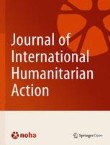The Journal of International Humanitarian Action is associated with the Network On Humanitarian Action (NOHA).
Lessons from the Interagency Emergency Health Kit for access to essential medicines in Canada
Despite Canada’s efforts to position itself as a global health leader, important medicines, including multiple drugs found on the WHO Model List of Essential Medicines, are not available domestically. Of the f...
